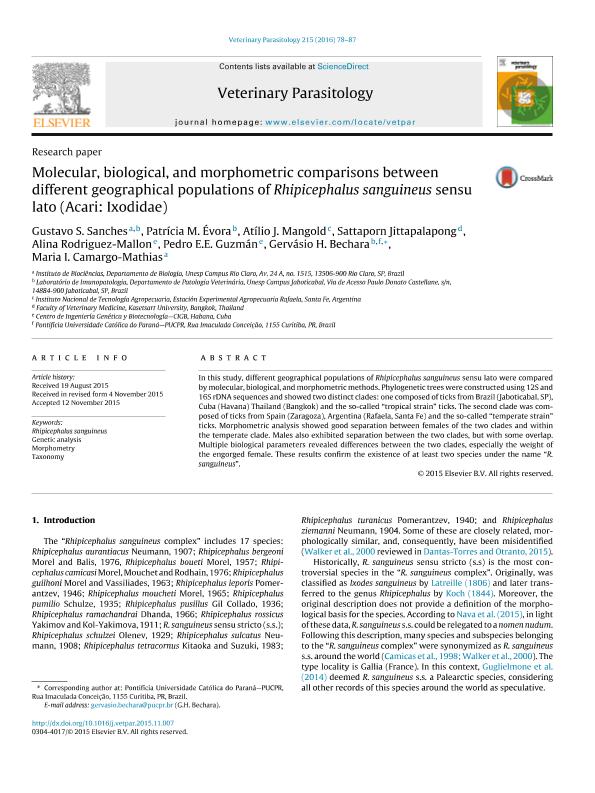Artículo
Molecular, biological, and morphometric comparisons between different geographical populations of Rhipicephalus sanguineus sensu lato (Acari: Ixodidae)
Sanches, Gustavo S.; Évora, Patrícia M.; Mangold, Atilio Jose ; Jittapalapong, Sattaporn; Rodriguez Mallon, Alina; Guzmán, Pedro E. E.; Bechara, Gervásio H.; Camargo Mathias, Maria I.
; Jittapalapong, Sattaporn; Rodriguez Mallon, Alina; Guzmán, Pedro E. E.; Bechara, Gervásio H.; Camargo Mathias, Maria I.
 ; Jittapalapong, Sattaporn; Rodriguez Mallon, Alina; Guzmán, Pedro E. E.; Bechara, Gervásio H.; Camargo Mathias, Maria I.
; Jittapalapong, Sattaporn; Rodriguez Mallon, Alina; Guzmán, Pedro E. E.; Bechara, Gervásio H.; Camargo Mathias, Maria I.
Fecha de publicación:
01/2016
Editorial:
Elsevier Science
Revista:
Veterinary Parasitology
ISSN:
0304-4017
Idioma:
Inglés
Tipo de recurso:
Artículo publicado
Clasificación temática:
Resumen
In this study, different geographical populations of Rhipicephalus sanguineus sensu lato were compared by molecular, biological, and morphometric methods. Phylogenetic trees were constructed using 12S and 16S rDNA sequences and showed two distinct clades: one composed of ticks from Brazil (Jaboticabal, SP), Cuba (Havana) Thailand (Bangkok) and the so-called "tropical strain" ticks. The second clade was composed of ticks from Spain (Zaragoza), Argentina (Rafaela, Santa Fe) and the so-called "temperate strain" ticks. Morphometric analysis showed good separation between females of the two clades and within the temperate clade. Males also exhibited separation between the two clades, but with some overlap. Multiple biological parameters revealed differences between the two clades, especially the weight of the engorged female. These results confirm the existence of at least two species under the name "R. sanguineus".
Palabras clave:
Genetic Analysis
,
Morphometry
,
Rhipicephalus Sanguineus
,
Taxonomy
Archivos asociados
Licencia
Identificadores
Colecciones
Articulos(CCT - SANTA FE)
Articulos de CTRO.CIENTIFICO TECNOL.CONICET - SANTA FE
Articulos de CTRO.CIENTIFICO TECNOL.CONICET - SANTA FE
Citación
Sanches, Gustavo S.; Évora, Patrícia M.; Mangold, Atilio Jose; Jittapalapong, Sattaporn; Rodriguez Mallon, Alina; et al.; Molecular, biological, and morphometric comparisons between different geographical populations of Rhipicephalus sanguineus sensu lato (Acari: Ixodidae); Elsevier Science; Veterinary Parasitology; 215; 1-2016; 78-87
Compartir
Altmétricas



